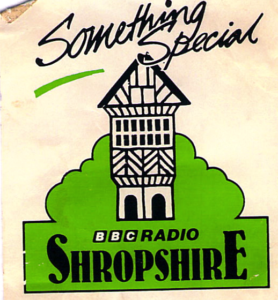
As I post, it’s still St. George’s Day: just. According to Wikipedia, St George rose to the position of the primary patron saint of England during the English Reformation. I didn’t see many references to St. George today, but I think most people across the country were thinking about the dragon rather than the Pope’s control of the Church in England.
If, however, you live in Shropshire – or you are a radio historian of some kind – you’ll know of today as the 32nd anniversary of the launch of BBC Radio Shropshire.
I am not sure that I would have mentioned it here accept for the fact that a few weeks ago I found an old cassette with copies of the pre-launch test transmissions from 4th and 9th of April 1985. I am sure that there’s lots that you can learn from those test transmissions but, what I find most fascinating, is that Radio Shropshire’s first voice, Diane Kemp,1 repeats the postal address in almost every link. The phone number is mentioned but, of course, there was no text, email, tweets or Facebooking. A few years later, one of my first jobs was answering the telephones for the afternoon shows on the station: regularly speaking to the characters that made up the county. It was the primary way to be part of the station, we’d call it interaction today. It definitely shows that our interaction with radio stations has changed massively in 32 years.
Also this week, one of those aforementioned radio historians, David Lloyd, wrote about the change in regulation now that BBC Local Radio is overseen by Ofcom. Today, I’m not sure BBC Local Radio has quite the same character that those test transmissions imply, but it remains a distinctive service. The regulation should ensure that the unique voice continues and not become “a BBC local service which is largely networked.”2
A few years ago I wrote about changes to the Shropshire Radio landscape, when Signal 1o7 launched and Beacon was re-branded to Free Radio, and pondered if bigger names were a blueprint for the 21st century: giving smaller stations a recognisable brand. Today, I remain convinced by the theory but, when I last listened to either of those stations in Shropshire, the key bit missing was anything about the county. Given Signal 107’s audience share is less than 2%,3 and Free Radio’s share in Shropshire is around 9%,4 have those brands lead to a reduction in local content which, in turn, means listeners tuning out? Or, is it purely a matter of increased competition? BBC Shropshire’s audience share is around 13%5 but I am not sure how to read that. Is local content important to audiences? Certainly, I would hope that Ofcom recognise that BBC Local Radio may be the last bastion of substantial amounts of local information on the radio. Isn’t the licence fee there to support content the commercially-funded stations can’t afford to?
I think BBC Local Radio is nicely summed-up in the words towards the end of my test transmission recordings,
There are stories in every village, every street, probably every home in Shropshire. Wonderful characters with a tale to tell; local gossip; a row over some local controversy; people with wonderful hobbies: eccentrics and fanatics, comedians and Jeremiahs, good deeds and bad deeds. We’re interested in the lot and the more you tell us about them, the more we can use. It’s that type of station. 6
I think that’s what makes local radio interesting. I hope Ofcom manages to keep it that way. Happy Birthday BBC Shropshire.
Footnotes
1 Diane Kemp, now Professor Diane Kemp at Birmingham City University’s School of Media
2 Goodbye from BBC Local Radio?, David Lloyd, 19 April 2017
3 December 2016 data, media.info. Total survey area for Signal 107 is greater than Shropshire.
4 December 2016 data, media.info, former Beacon Shropshire area.
5 December 2016 data, media.info.
6 Test transmissions: https://soundcloud.com/curns/4th-9th-april-1985-test-transmissions-edit